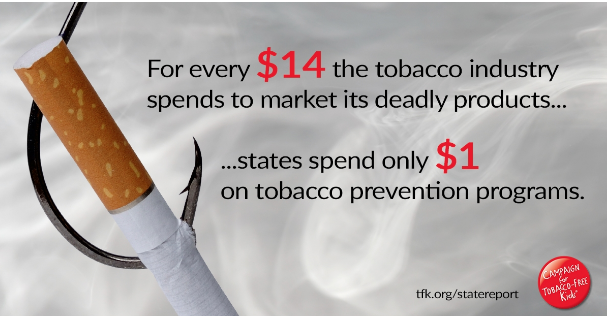The Campaign for Tobacco-Free Kids and others have issued a 20th annual report, Broken Promises to our Children, which details how states are spending revenues from both tobacco taxes and tobacco company payments made as part of a 1998 settlement agreement.
This report is issued by the Campaign for Tobacco-Free Kids, American Heart Association, American Cancer Society Cancer Action Network, American Lung Association, Robert Wood Johnson Foundation, Americans for Nonsmokers’ Rights and Truth Initiative.
The report found that Kentucky spends just 6.7 percent of the U.S. Centers for Disease Control and Prevention (CDC) recommended amount for tobacco prevention and cessation programs designed to address the public health problems caused by tobacco in the Commonwealth.
The report ranks Kentucky at 35th in the nation for tobacco prevention funding. In fiscal 2020, the state will receive an estimated $507.3 million and has allocated $3.8 million for prevention efforts.
The CDC-recommended expenditure for prevention in Kentucky is $56.4 million.
“Kentucky gets more than $500 million a year in tobacco tax revenues, but we spend less than $4 million on preventing tobacco-related diseases and helping people break their nicotine addiction,” said Ben Chandler, Chair of the Coalition for a Smoke-Free Tomorrow.
“Kentucky simply can no longer afford this off-kilter equation. Our healthcare costs for smoking-related diseases total $1.92 billion every year. The Master Settlement Agreement was intended to help mitigate the cost of Big Tobacco’s addiction-model business plan.
“We’re grateful for the additional funding included in the next budget, and will advocate for continued increases to prevent a new generation with tobacco addiction, and to help current smokers quit for good.”
Since the states settled their lawsuits against the major tobacco companies in 1998, the annual reports have assessed whether the states are keeping their promise to use a significant portion of their settlement funds – estimated at $246 billion over the first 25 years – to attack the enormous public health problems caused by tobacco use in the United States.
Despite receiving huge sums from the settlement and collecting billions more in tobacco taxes, the states continue to shortchange tobacco prevention and cessation programs that are proven to save lives and reduce health care costs.
In the current budget year, Fiscal Year 2019, the states will collect $27.3 billion from the settlement and taxes. But they will spend just 2.4 percent of it – $655 million – on programs to prevent kids from smoking and help smokers quit.

Meanwhile, tobacco companies spend $9.5 billion a year – $1 million every hour – to market their deadly and addictive products. This means tobacco companies spend $14 to market their products for every $1 the states spend to reduce tobacco use.
The report challenges states to do more to fight tobacco use – still the nation’s No. 1 cause of preventable death and disease – to accelerate progress, address large disparities in who still smokes, and confront the growing epidemic of youth e-cigarette use in America.
Other key findings include:
The $655 million the states have budgeted for tobacco prevention amounts to less than 20 percent of the $3.3 billion the Centers for Disease Control and Prevention (CDC) recommends for all states combined. Not a single state currently funds tobacco prevention programs at the level recommended by the CDC.
Only two states – California and Alaska – provide even 70 percent of the recommended CDC funding. Twenty-eight states and the District of Columbia are spending less than 20 percent of what the CDC recommends.
States with well-funded, sustained tobacco prevention programs continue to report significant progress. Florida, with one of the longest-running programs, reduced its high school smoking rate to 3.6 percent in 2018, one of the lowest ever reported by any state.
Along with separate policy actions, including higher tobacco taxes and comprehensive smoke-free laws, the settlement has helped drive down smoking rates to record lows – 14 percent among adults and 7.6 percent among high school students in 2017. But tobacco use still kills more than 480,000 Americans and costs the nation about $170 billion in health care expenses each year.
The battle against tobacco is entirely winnable if proven strategies are fully implemented. But enormous challenges remain. The latest data show that 34.3 million U.S. adults still smoke and 47 million – about 1 in 5 adults – still use some form of tobacco. There are large disparities in who still smokes and who suffers from tobacco-related disease, with especially high smoking rates among people with lower income and less education and other specific populations. In addition, the youth e-cigarette epidemic, driven by the skyrocketing popularity of Juul, is an urgent challenge that must be addressed to prevent yet another generation from becoming addicted to nicotine.
Kentucky Coalition for Smoke-Free Tomorrow

















